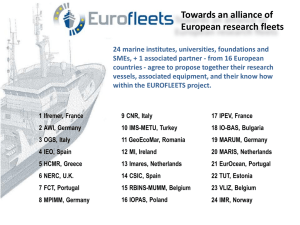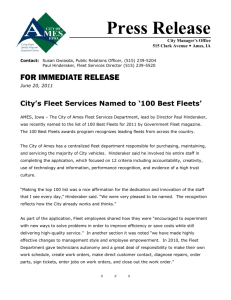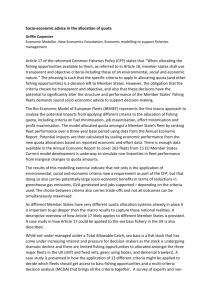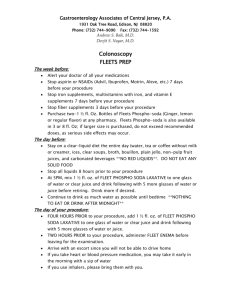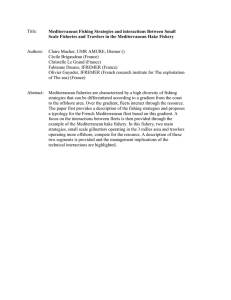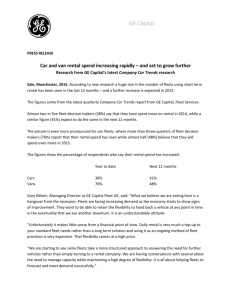A COMPARATIVE ANALYSIS OF RECENT TRENDS IN THE CHARACTERISTICS OF
advertisement
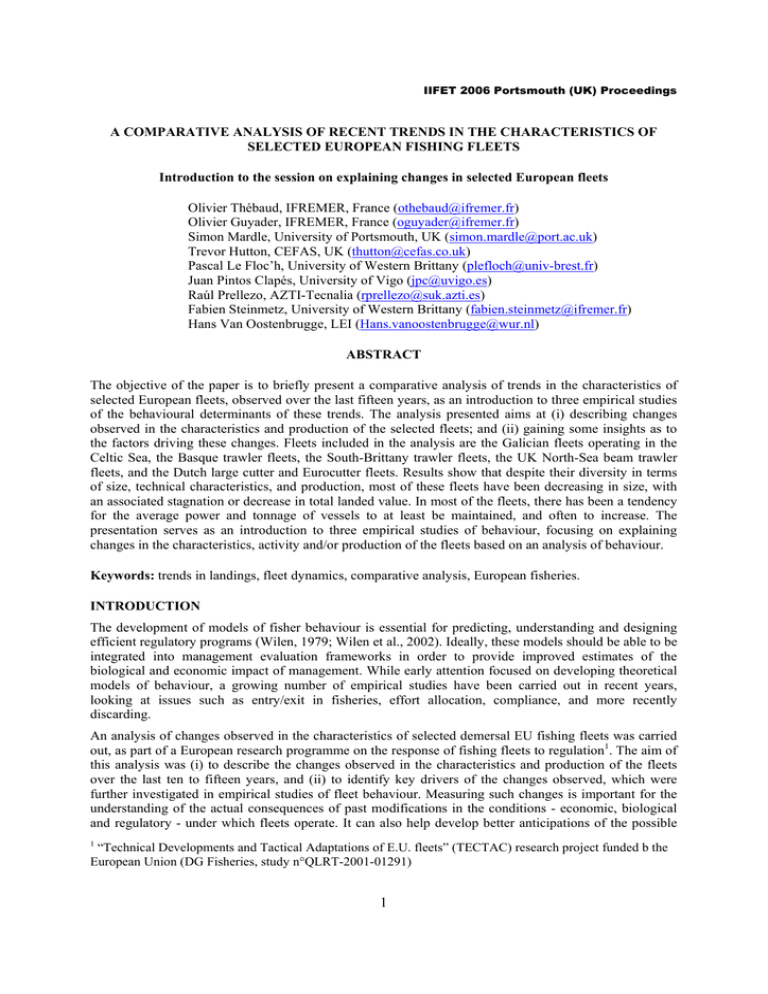
IIFET 2006 Portsmouth (UK) Proceedings A COMPARATIVE ANALYSIS OF RECENT TRENDS IN THE CHARACTERISTICS OF SELECTED EUROPEAN FISHING FLEETS Introduction to the session on explaining changes in selected European fleets Olivier Thébaud, IFREMER, France (othebaud@ifremer.fr) Olivier Guyader, IFREMER, France (oguyader@ifremer.fr) Simon Mardle, University of Portsmouth, UK (simon.mardle@port.ac.uk) Trevor Hutton, CEFAS, UK (thutton@cefas.co.uk) Pascal Le Floc’h, University of Western Brittany (plefloch@univ-brest.fr) Juan Pintos Clapés, University of Vigo (jpc@uvigo.es) Raúl Prellezo, AZTI-Tecnalia (rprellezo@suk.azti.es) Fabien Steinmetz, University of Western Brittany (fabien.steinmetz@ifremer.fr) Hans Van Oostenbrugge, LEI (Hans.vanoostenbrugge@wur.nl) ABSTRACT The objective of the paper is to briefly present a comparative analysis of trends in the characteristics of selected European fleets, observed over the last fifteen years, as an introduction to three empirical studies of the behavioural determinants of these trends. The analysis presented aims at (i) describing changes observed in the characteristics and production of the selected fleets; and (ii) gaining some insights as to the factors driving these changes. Fleets included in the analysis are the Galician fleets operating in the Celtic Sea, the Basque trawler fleets, the South-Brittany trawler fleets, the UK North-Sea beam trawler fleets, and the Dutch large cutter and Eurocutter fleets. Results show that despite their diversity in terms of size, technical characteristics, and production, most of these fleets have been decreasing in size, with an associated stagnation or decrease in total landed value. In most of the fleets, there has been a tendency for the average power and tonnage of vessels to at least be maintained, and often to increase. The presentation serves as an introduction to three empirical studies of behaviour, focusing on explaining changes in the characteristics, activity and/or production of the fleets based on an analysis of behaviour. Keywords: trends in landings, fleet dynamics, comparative analysis, European fisheries. INTRODUCTION The development of models of fisher behaviour is essential for predicting, understanding and designing efficient regulatory programs (Wilen, 1979; Wilen et al., 2002). Ideally, these models should be able to be integrated into management evaluation frameworks in order to provide improved estimates of the biological and economic impact of management. While early attention focused on developing theoretical models of behaviour, a growing number of empirical studies have been carried out in recent years, looking at issues such as entry/exit in fisheries, effort allocation, compliance, and more recently discarding. An analysis of changes observed in the characteristics of selected demersal EU fishing fleets was carried out, as part of a European research programme on the response of fishing fleets to regulation1. The aim of this analysis was (i) to describe the changes observed in the characteristics and production of the fleets over the last ten to fifteen years, and (ii) to identify key drivers of the changes observed, which were further investigated in empirical studies of fleet behaviour. Measuring such changes is important for the understanding of the actual consequences of past modifications in the conditions - economic, biological and regulatory - under which fleets operate. It can also help develop better anticipations of the possible 1 “Technical Developments and Tactical Adaptations of E.U. fleets” (TECTAC) research project funded b the European Union (DG Fisheries, study n°QLRT-2001-01291) 1 IIFET 2006 Portsmouth (UK) Proceedings impacts of future changes in these conditions, and in particular of new regulations applied to the fisheries in which the fleets operate. The objective of the paper is to briefly present a comparative analysis of trends in the characteristics of the selected European fleets, as an introduction to three empirical studies of behaviour in these fleets. The paper is structured as follows. The first section presents a descriptive account of the fleets considered for the analysis, and of the trends observed in their structure, physical characteristics, production and gross turnover. The second section discusses these results with respect to the categories of behaviour which have played a determinant role in some of the changes observed, and introduces the three empirical studies which were designed to explore this. FLEET CHARACTERISTICS AND TRENDS OBSERVED We define fleets as groups of vessel with comparable physical characteristics (i.e. size, power and tonnage), operating in a given set of fisheries with similar fishing techniques. The following table summarizes key indicators regarding the size, characteristics and production of vessels in the fleets studied, for the last year for which data was available. Table 1 – Evolution of physical capital, production per unit of physical capital, prices, and revenue Fleet size (number of vessels)† Average engine power per vessel (KW) Average tonnage per vessel (GRT) Average annual landings (Tons/vessel)** Average annual landings (KEuro 2003/vessel) ** Average annual price per kg (Euro 2003) English North-Sea beam trawlers (≤221 3 171 n.a. 21 70 3.30 kW) Dutch Eurocutters 173 220 81 122 373 3.10 French South 97 223 31.2 59.7 300 5.00 Brittany trawlers [12-16m[ French South 66 295 42 119 472 4.00 Brittany trawlers [16-20m[ French South Brittany trawlers 108 407 82 217 712 3.30 [20-24m[ Galician fleets 196 457 199 166 871 5.20 Basque “Baka” 24 634 239 121 574 4.70 trawlers Basque pair trawlers 18 683 246 402 1 270 3.20 English North Sea beam trawlers (>221 15 1300 n.a. 447 764 1.70 kW) Dutch large cutters 130 1670 445 362 1 367 3.80 † UK summary data relates to the aggregated average vessel beam trawl activity by month during 2003. The measurement of total tonnage has been complicated by a change in methodology used to measure the tonnage of vessels that was introduced from 1996 onwards – this indicator has not been presented for the UK cases. * 2002 for Basque fleets; provisional 2003 data for Dutch fleets. ** For the Basque fleets only Hake, Megrim and Anglerfish have been taken into account. Fleets ranked by order of increasing average engine power. 2 IIFET 2006 Portsmouth (UK) Proceedings In addition to the fleets considered in this table, the project also included analysis of the Danish North Sea Gillnet fleet, which, during the last decade, have contributed to around 30% of the total annual Danish landing (in value) of demersal species in the North Sea. The table illustrates the diversity of the fleets that were considered in the project, ranging from the small trawler fleets operating off the coast of South-Brittany (France) to the large cutter and beam trawl fleets operating in the North Sea. While on average for the year considered, there is a good correspondence between vessel engine power and vessel tonnage in the different fleets, there appears to be no strong correlation between vessel size and average annual production in volume, and/or in value: according to the statistics presented here, vessels of relatively smaller size and horsepower achieve levels of catches similar to those observed for vessels of much larger size and power. Important differences in the average annual prices fetched by the fleets also exist, with observations ranging between 3.1 and 5.2 euros per kilo depending on the fleet. This indicates significantly different fishing activity profiles, depending on the fleets, the areas in which they operate, the species targeted and the markets of their production. Trends in the size, physical characteristics of vessels, production and gross turnover in the selected fleets Despite this diversity, a number of common traits emerge from the analysis of decadal changes observed in the size, characteristics, and production of the fleets studied, as is illustrated in table 2 below2. In particular, the size (number of vessels) of most of the fleets studied has globally decreased over the study period, with the exception of the Dutch Eurocutter fleet which has regularly increased in size since 1990. Strong reductions in fleet size have occurred in fleets of smaller vessels, while fleets of larger vessels have witnessed more limited reductions (with the exception of the UK fleet of large beam trawlers). This translates into reductions of output. While Dutch Eurocutters, South-Brittany larger trawlers and Basque pair trawlers have increased of maintained their total output in volume, all the other fleets have seen their landings decrease, most of them substantially. Except in the case of the Galician fleets, this reduction does not seem to have been compensated by price changes, hence gross turnover has also decreased for most fleets. For example, for English beam trawl vessels (>221 kW) operating in the North Sea, total volume landed and the associated total value of that catch has reduced to half the level from 1990, but to a third of the level at its high point in 1993. In the case of South Brittany trawlers, volumes landed and the associated turnover were reduced by half for the group of smaller vessels, and by 60% for the group of vessels of intermediate size. In most of the fleets, there has been a tendency for the average power and tonnage of vessels to maintain itself or increase. The only exception is the Baka trawlers, which have seen a decrease in their average power and tonnage. Hence, the composition of the fleets has evolved in relation to the characteristics of vessels exiting and entering the fleets. Average annual landings per vessel display more contrasting trends, with a predominantly increasing apparent productivity of vessels in volume and value. In a majority of the fleets, average annual landings in volume have either been maintained or increased, with some fluctuations not apparent in the table. In most cases, this has translated into equivalent or higher increases in the average annual gross turnover of vessels, depending on the changes observed in the prices fetched by the fleet’s landings. Three fleets, the English small beam trawlers, the Dutch large cutters and the Basque “Baka” trawlers show decreasing annual landings per vessel. In all three cases, there is an associated drop in the observed annual turnover per vessel. 2 The trends are considered over the entire period for which data was available. They can mask important fluctuations, such as in the case of the [16-20m[ trawler fleet of South-Brittany, the case of the Basque Pair trawlers or the case of the English North Sea beam trawlers (≤221 kW). 3 IIFET 2006 Portsmouth (UK) Proceedings Table 2 – Observed trends in the characteristics and total production of the selected fleets (variable reference period*) Fleet size (number of vessels) Average engine power per vessel (KW) Average tonnage per vessel (GRT) Total landings (Tons) Gross turnover (mEuros) Average annual landings (Tons per vessel) Average annual landings (KEuro 2003/vessel) English NorthSea beam = = -/= -/= trawlers (≤221 kW) Dutch + = = + + +/= -/= Eurocutters French South Brittany trawlers +/= +/= +/= + [12-16m[ French South Brittany trawlers = = = = [16-20m[ French South Brittany trawlers -/= = +/= = = = = [20-24m[ Galician fleets -/= +/= = -/= +/= = +/= Basque “Baka” -/= -/= -/= -/= + trawlers Basque pair -/= +/= = + + +/= trawlers English North Sea beam +/= = = + trawlers (>221 kW) Dutch large -/= = +/= -/= cutters *1990-2003 for French and Dutch fleets; 1997-2003 for Galician fleets; 1996-2002 for Basque fleets. “+”: >25% increase; “-“: >25% decrease; “+/=”: 5-25% increase; “-/=”: 5-25% decrease. Fleets ranked by order of increasing average engine power. DISCUSSION AND INTRODUCTION TO THE EMPIRICAL STUDIES Analysis of the observed trends provides some insights as to the potential role of the different factors which may have driven changes observed in the fleets and their total output. These factors relate mainly to (i) modifications in the size of the fleets (usually a reduction); (ii) changes in the average characteristics of individual vessels; and (iii) changes in the production and turnover of individual vessels. The analysis of choices underlying these changes was carried out for a number of the fleets considered in the study. The first category of change can be related to medium to long-term choices by fishing firms of operating a vessel in a given fishery, in a given year. Indeed, for certain fleets, this appears as a major determinant of the observed (negative) trends in the total turnover generated. While, in the context of a market economy, this can be expected to depend on anticipations of the net profits which can be derived from such choices, decisions are also constrained and/or influenced by the regulations applying to entry and exit into fisheries. The implementation of European capacity reduction programmes over the study period thus has to be included in the analysis of this component of fleet dynamics. This is the objective of the first 4 IIFET 2006 Portsmouth (UK) Proceedings empirical study, by Mardle et al., which compares models of entry-stay-exit choices developed for three of the fleets considered in the project. The second category of change relates to medium-term choices made by fishing firms as regards investment, leading to changes in the characteristics of fishing vessels. Such choices lead for example to the changes in the composition of fleets observed in terms of the average size and power of fishing vessels. They also apply to the other components of fishing equipment which affect the capacity of the fishing units, not measured in the tables above. In a number of cases, there appears to have been significant increases in the average performance of vessels remaining in the fleets, in relation to technological development. These changes relate to choices made in the adoption of new techniques, and new ways of fishing, which are at the centre of the second empirical study, by Hutton et al., which focuses on the measurement via a survey of the nature, rate and causes of the adoption of new techniques by vessel owners3. The third category of change can be directly related to the two previous categories of choices. Reductions in a fleet’s size, and improvements in the technical characteristics of vessels, all else equal, can have direct consequences on the individual performance of fishing units. The analysis carried out in the project however showed that the resulting changes were also determined by modifications in catch possibilities, and in market conditions, via the short-term choices made by fishing firms in terms of species and areas targeted. For example, in the Spanish context, changes in the Total Allowable Catch (TAC) of key species have had strong impacts on fleet revenues during the period studied, as is illustrated by the impact of reduction in allowable catches of hake on the revenue of Galician fleets. The Dutch large cutter fleets and English beam trawl fleets (>221 kW) have also been confronted to a reduction in catch limitations for all the economically important species, including the most important ones (sole and plaice). In the Dutch case, this reduction has only partly been compensated for by an increase in the apparent productivity of vessels for these and other species, which explains the observed drop in total landings per GRT of the large cutter vessels during the study period. In the UK case, a move to other species such as anglerfish, lemon sole, dab and megrim has offset the reduction in TACs for plaice and sole and on average has improved revenues per vessel. Such choices are considered in the third empirical study, by Prellezo et al. REFERENCE Anonymous (2005). “Technical Developments and Tactical Adaptations of E.U. fleets” (TECTAC) research project funded b the European Union (DG Fisheries, study n°QLRT-2001-01291). Final Report, December. Wilen, J.E. 1979. Fisherman behavior and the design of efficient fisheries regulation programs. Journal of the Fisheries Research Board of Canada 36: 855-858. Wilen, J.E., M.D. Smith, D. Lockwood and F.W. Botsford 2002. Avoiding surprises: Incorporating fisherman behavior into management models. Bulletin of Marine Science 70(2): 553-575. 3 The survey also included questions related to the decisions to enter stay or exit a given fleet, and to fishing strategies (see below). 5


